The Paper Core Cutting Machine Market is estimated to be valued at USD 288.4 billion in 2025 and is projected to reach USD 402.8 billion by 2035, registering a compound annual growth rate (CAGR) of 3.4% over the forecast period.
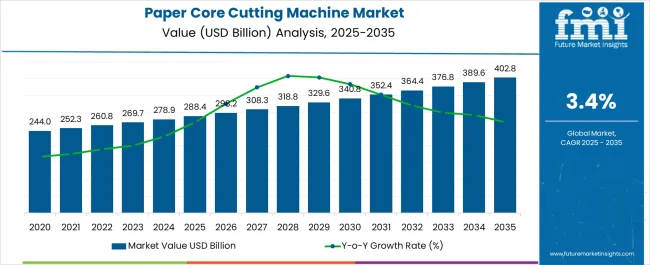
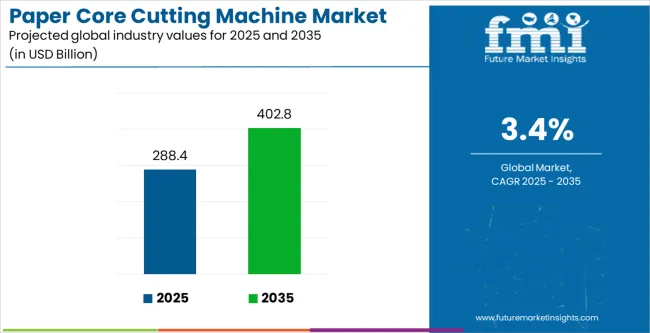
| Metric | Value |
|---|---|
| Paper Core Cutting Machine Market Estimated Value in (2025 E) | USD 288.4 billion |
| Paper Core Cutting Machine Market Forecast Value in (2035 F) | USD 402.8 billion |
| Forecast CAGR (2025 to 2035) | 3.4% |
The paper core cutting machine market is expanding steadily, supported by rising demand for efficient converting equipment across diverse industries such as textiles, packaging, and paper production. Growth is being influenced by increasing requirements for precise cutting, reduced material wastage, and enhanced operational productivity.
Manufacturers are focusing on delivering user friendly, cost effective machines that align with both small scale and large scale industrial needs. Advancements in automation and control systems are further reshaping the market, enabling higher throughput with improved accuracy.
Additionally, the textile and packaging sectors are showing significant adoption due to their dependency on consistent quality cores for spooling and winding applications. The future outlook remains positive as investments in modern manufacturing infrastructure and the adoption of energy efficient equipment continue to drive widespread deployment of paper core cutting machines globally.
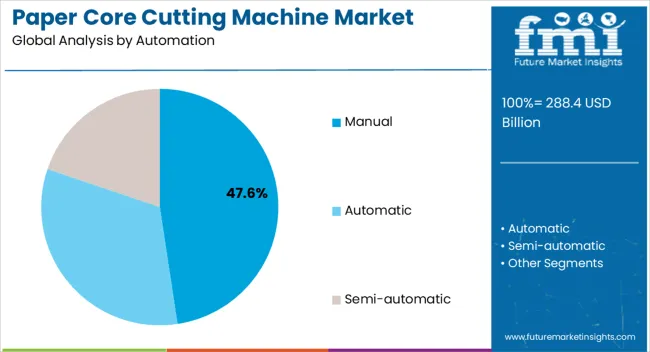
The manual automation segment is projected to account for 47.60% of market revenue in 2025, making it the leading automation category. Its dominance is attributed to affordability, ease of installation, and suitability for small and medium enterprises that prioritize cost effective solutions over advanced automation.
The ability of manual machines to deliver consistent output with minimal technical expertise has further reinforced adoption. These machines also require lower maintenance costs, making them particularly attractive in regions where capital investments in automation remain limited.
As a result, manual systems continue to hold a significant share, especially in price sensitive markets.
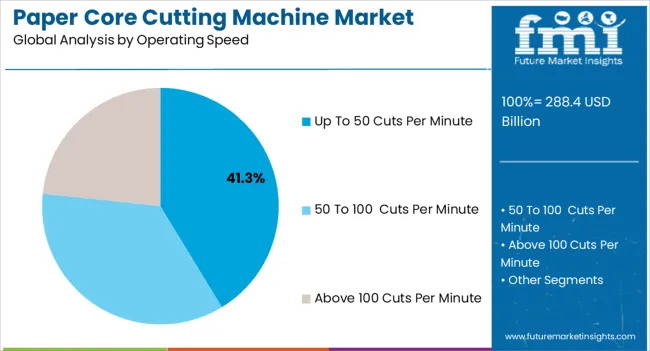
The operating speed category of up to 50 cuts per minute is expected to hold 41.30% of total revenue share by 2025. This segment has gained prominence as it provides an optimal balance between production efficiency and equipment cost.
The speed range is well suited for industries requiring moderate throughput while maintaining high levels of precision. Energy efficiency and reduced wear and tear are also key drivers supporting adoption.
Small and mid sized manufacturers particularly prefer this range due to its reliability and capacity to meet consistent daily production needs without excessive investment.
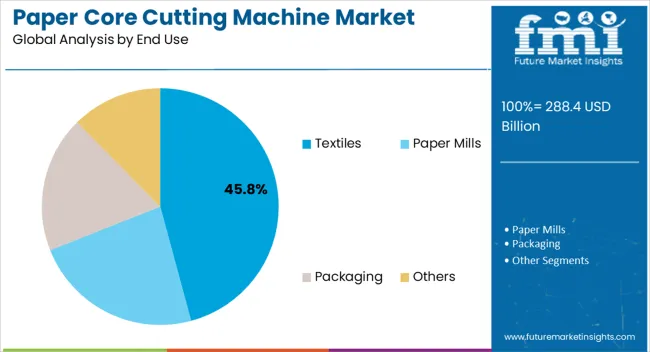
The textiles industry segment is anticipated to contribute 45.80% of total revenue by 2025 within the end use category, positioning it as the leading segment. Growth is being fueled by rising demand for high quality paper cores used in winding and spooling of yarns, fabrics, and threads.
The textile sector requires uniform and durable cores to maintain efficiency in large scale production processes. Increasing investments in modern textile facilities and the expansion of fabric exports are reinforcing the demand for reliable core cutting machines.
The durability, cost effectiveness, and adaptability of machines for various textile applications have ensured their strong presence in this industry, thereby cementing its leadership position in the overall market.
From 2020 to 2025, the global paper core cutting machine market experienced a CAGR of 2.0%, reaching a market size of USD 288.4 million in 2025 from USD 244 million in 2020. Paper cores are basically the long tubes majorly used in many applications such as paper towels, cable reels, and others. Paper tubes are also called as spiral wound paper cores or paper tubes.
Paper core cutting machines are employed in manufacturing industries for precise cutting and machining of the paper tubes. Increasing demand for paper cores from various industries such as textiles, adhesive tapes, and wires is one of the significant factor for the paper core cutting machines market growth. Furthermore, the paper cores are reusable, recyclable, and eco-friendly solutions makes it a sustainable option.
As a result, the paper core cutting machines market has shown a significant growth. The waste generated from the paper core cutting machines is less and also it can be again reused and recycled further. The convenience provided by the paper cores and wide applications of the paper core are contributing to the growth of paper core cutting machine market.
Looking ahead, the global paper core cutting machine market is expected to rise at a CAGR of 3.4% from 2025 to 2035. During the forecast period, the market size is expected to reach USD 402.8 million in 2035.
With the increasing demand for paper cores from end use industries such as textiles, electrical, adhesive, converting, and shipping and storage industry, the demand for the paper core cutting machine is expected to be at the forefront during the projected years.
The requirement for high speed machineries along with accurate results from the manufacturing industries is attributing towards the growth of the paper core cutting machine market. With the advancement in technology and the increasing adoption of automation in the manufacturing sector, the paper core cutting machine industry is expected to grow at a significant rate during the forecast period.
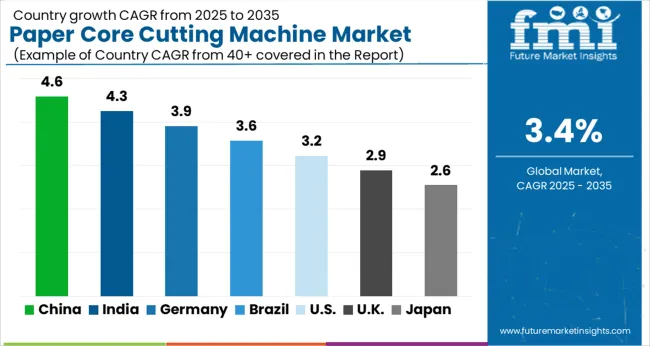
| Country | China |
|---|---|
| Market Size (USD million) by End of Forecast Period (2035) | USD 84.0 million |
| CAGR % 2025 to End of Forecast (2035) | 3.3% |
According to World Integrated Trade Solutions (WITS), China is at the top in the import of textiles and clothing. China is the manufacturing hub with the establishment of various industries from different sectors. The manufacturing sector in China requires automated machines to meet the demand for products. Thus, China is expected to propel the paper-core cutting machine market.
| Country | India |
|---|---|
| Market Size (USD million) by End of Forecast Period (2035) | USD 37.7 million |
| CAGR % 2025 to End of Forecast (2035) | 3.8% |
India is one of the fastest-growing countries in the Asia Pacific. Paper and packaging Industry in India has shown significant growth in recent years and has a future growth potential for the industry. According to India Brand Equity Foundation (IBEF), the paper and packaging Sector in India is estimated to reach USD 288.4 billion in 2025 expanding at a CAGR of 26.7%.
The paper and packaging industry in India is the fifth largest sector of the Indian economy. Paper core cutting machine is an essential part of the packaging industry. As a result, India is expected to create growth opportunities for the paper core cutting machine market in the future.
The semi-automatic machine type segment dominates the paper core cutting machine market with a market share of 52.2% in the estimated year. This segment captures a significant market share in 2025 due to its affordability and clean precise cutting. It is majorly preferred by small and medium-scale enterprises for paper core cutting. In most developing countries, the availability of cheap labor allows manufacturers to install the semi-automatic machine.
The packing segment is expected to record a CAGR of 5.0% during the forecast period. The packaging industry is creating an enormous amount of opportunities for the paper core cutting market. Paper cores are being majorly used in tapes, labels, adhesives, and other applications. Also, with the growing concerns over plastic use and its environmental hazards, packaging manufacturers are moving towards the use of paper and paper boards. As a result, the packaging segment is anticipated to create growth in paper core cutting machines in the forecast years.
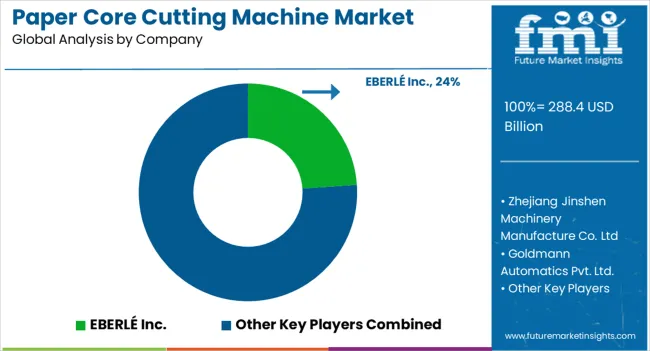
The key players in the paper core cutting machine market are focusing on innovative strategies by developing automatic machines providing maximum output and accurate results. Manufacturers are developing the machines according to the consumer’s demands for the cutting speed, size, and length of the cores.
Key Strategies Adopted by the Players
The major companies are trying to collaborate, which can help them gain competitive advantage, and also gain access to advanced technologies.
Companies are trying to improve their production efficiency and accuracy by highly investing in research and development. Some of the companies are trying to provide the product with minimum cost, which can be affordable for small and medium scale. This can eventually increase the adoption rate of the paper core cutting machine.
The major key players are investing and expanding their channels into emerging economies which can help them gain market position. This strategy is helping them to increase their customer base.
Key Developments in the Paper Core Cutting Machine Market:
The global paper core cutting machine market is estimated to be valued at USD 288.4 billion in 2025.
The market size for the paper core cutting machine market is projected to reach USD 402.8 billion by 2035.
The paper core cutting machine market is expected to grow at a 3.4% CAGR between 2025 and 2035.
The key product types in paper core cutting machine market are manual, automatic and semi-automatic.
In terms of operating speed, up to 50 cuts per minute segment to command 41.3% share in the paper core cutting machine market in 2025.






Full Research Suite comprises of:
Market outlook & trends analysis
Interviews & case studies
Strategic recommendations
Vendor profiles & capabilities analysis
5-year forecasts
8 regions and 60+ country-level data splits
Market segment data splits
12 months of continuous data updates
DELIVERED AS:
PDF EXCEL ONLINE
Paper Edge Protector Market Size and Share Forecast Outlook 2025 to 2035
Paper Cup Lids Market Size and Share Forecast Outlook 2025 to 2035
Paper Pallet Market Size and Share Forecast Outlook 2025 to 2035
Paper and Paperboard Packaging Market Forecast and Outlook 2025 to 2035
Paper Wrap Market Size and Share Forecast Outlook 2025 to 2035
Paper Cups Market Size and Share Forecast Outlook 2025 to 2035
Paper Bags Market Size and Share Forecast Outlook 2025 to 2035
Paper Processing Resins Market Size and Share Forecast Outlook 2025 to 2035
Paper Tester Market Size and Share Forecast Outlook 2025 to 2035
Paper Napkin Converting Lines Market Size and Share Forecast Outlook 2025 to 2035
Paper Packaging Tapes Market Size and Share Forecast Outlook 2025 to 2035
Paper Coating Binders Market Size and Share Forecast Outlook 2025 to 2035
Paper Recycling Market Size and Share Forecast Outlook 2025 to 2035
Paper Release Liners Market Size and Share Forecast Outlook 2025 to 2035
Paper Coating Materials Market Size and Share Forecast Outlook 2025 to 2035
Paper Pigments Market Size and Share Forecast Outlook 2025 to 2035
Paper Honeycomb Market Size and Share Forecast Outlook 2025 to 2035
Paper Paperboard Wood Recycling Market Size and Share Forecast Outlook 2025 to 2035
Paper Goods Market Size and Share Forecast Outlook 2025 to 2035
Paper-based Blister Packs Market Analysis Size and Share Forecast Outlook 2025 to 2035

Thank you!
You will receive an email from our Business Development Manager. Please be sure to check your SPAM/JUNK folder too.
Chat With
MaRIA